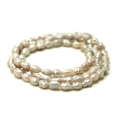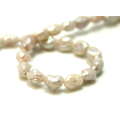

Freshwater pearl string, rice, light grey, 6mm, 40cm - Silver Hills 0.01kg
Check my rate
| Main centres: | 1-3 business days |
| Regional areas: | 3-4 business days |
| Remote areas: | 3-5 business days |
Product details
Where Do Pearls Come From?
All pearls grow inside certain varieties of hinged-shell mollusk known as bivalves. These creatures can open or close their casings at will, and a hungry specimen will spend hours under water with its shell at half-mast in hopes of catching some food. This open-door policy provides easy access to pearl-producing irritants. While any of the 20,000 species of bivalve can conceivably produce a pearl, relatively few of them actually do this with any regularity.
How is a Pearl Formed?
Every pearl develops in response to an irritant inside the body of the mollusk that produces it. In the wild, the culprit could be a bit of dirt, a grain of sand, or a tiny parasite. Since the mollusk cannot eject the intruder, it responds by surrounding it with layers of an iridescent substance known as nacre. This is the same mother-of-pearl material that coats the inside of its shell. With the passage of time, the mollusk will continue adding layers of nacre that increase the size of the pearl. The longer the irritated mollusk remains alive, the larger its pearl is likely to grow. No two mollusks are created equal, and neither is the nacre with which they come equipped. This diversity of composition is responsible for the wide variety of pearls produced by different mollusks. It is also the reason that some of these creatures are far more prolific than others.
Natural Pearls
A natural pearl is nothing more than a pearl that has formed spontaneously inside the mollusk without the aid of human intervention. These pearls are the rarest and most valuable. Cultured Pearls Cultured pearls are just as real as the natural variety. They grow inside the mollusk in exactly the same way. They are not imitation, and they are not fake. A cultured pearl necklace is as genuine as its natural cousin. The majority of cultured pearls available today derive from freshwater mussels and saltwater pearl oysters. Although all pearls develop in the same way, the cultured pearl requires some human assistance to get the process started. To do this, the pearl farmer inserts a small bead or section of mantle tissue under the mollusk’s shell. Nature then takes over. The animal begins to deposit layers of nacre around the irritating substance, slowly building up the cultured pearl. Cultured pearls so closely resemble the natural variety that experts often find it difficult to tell the two types apart. A final determination frequently requires the use of an X-ray to identify the initial irritant deep in the pearl’s interior.